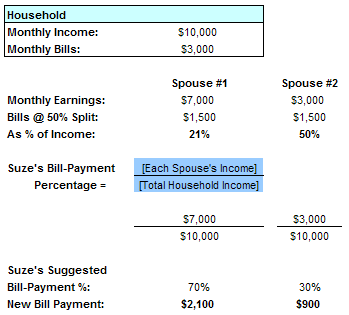“How should we split the bills?”
Suze says (on the Suze Orman Show which aired 2007/01/13) this is the most common question she gets from couples. (I’d have thought she’d hear “Should we have separate accounts, or joint?” more, but what do I know.)
For most folks, the default answer to the bill-splitting quandary is 50/50. But Suze suggests that it’s almost never this easy (no kidding!). And that for couples where the two spouses earn significantly different amounts (which would be most couples, probably), splitting the bills 50/50 will almost always lead to resentment and frustration.
Here’s the fictional household setup that Suze presented as an example:
Partner #1 makes $7k/month.
Partner #2 makes $3k/month.
Household expenses total $3k/month.
In the case above, Suze would suggest that the bills be split 70/30, rather than 50/50. This way, each partner/spouse is responsible for an equal percentage of the bills rather than an equal dollar amount. They don’t earn equal dollar amounts, so they shouldn’t pay equal dollar amounts.
After all, paying $1,500 worth of bills (a 50/50 split) drains the $3k earner a lot more, percentage-wise, than it does the $7k earner.

My first thought, of course, is that there are roughly four couples out there making $10k per month and spending only $3k/month, so the example is kind of flimsy in that regard. Numbers like that just ain’t happening for Joe and Jane Sixpack. Still, I recognize that it’s the math that matters.
I’m all for fairness in relationships and finances, and Suze’s idea makes sense to me: Pay the bills in the same percentage that the household income is split. Still, I can already hear the uproar from the “But we’re married, and we’re ONE now!” crowd. “What’s hers is mine, and what’s mine is hers! The only percentage that matters is the one we’re paying on our Discover card!”
And they have a valid case. Really, I think Suze’s point was meant more for non-married couples, but she wasn’t really clear on this. My advice, in any case, would be this:
Just do what works.
And if what you’re doing isn’t working, change it.

